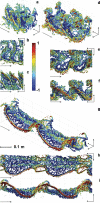Ear-body lift and a novel thrust generating mechanism revealed by the complex wake of brown long-eared bats (Plecotus auritus)
- PMID: 27118083
- PMCID: PMC4846812
- DOI: 10.1038/srep24886
Ear-body lift and a novel thrust generating mechanism revealed by the complex wake of brown long-eared bats (Plecotus auritus)
Abstract
Large ears enhance perception of echolocation and prey generated sounds in bats. However, external ears likely impair aerodynamic performance of bats compared to birds. But large ears may generate lift on their own, mitigating the negative effects. We studied flying brown long-eared bats, using high resolution, time resolved particle image velocimetry, to determine the aerodynamics of flying with large ears. We show that the ears and body generate lift at medium to cruising speeds (3-5 m/s), but at the cost of an interaction with the wing root vortices, likely reducing inner wing performance. We also propose that the bats use a novel wing pitch mechanism at the end of the upstroke generating thrust at low speeds, which should provide effective pitch and yaw control. In addition, the wing tip vortices show a distinct spiraling pattern. The tip vortex of the previous wingbeat remains into the next wingbeat and rotates together with a newly formed tip vortex. Several smaller vortices, related to changes in circulation around the wing also spiral the tip vortex. Our results thus show a new level of complexity in bat wakes and suggest large eared bats are less aerodynamically limited than previous wake studies have suggested.
Figures




Similar articles
-
Body lift, drag and power are relatively higher in large-eared than in small-eared bat species.J R Soc Interface. 2017 Oct;14(135):20170455. doi: 10.1098/rsif.2017.0455. J R Soc Interface. 2017. PMID: 29070593 Free PMC article.
-
Aerodynamics of manoeuvring flight in brown long-eared bats (Plecotus auritus).J R Soc Interface. 2018 Nov 7;15(148):20180441. doi: 10.1098/rsif.2018.0441. J R Soc Interface. 2018. PMID: 30404906 Free PMC article.
-
Bat flight: aerodynamics, kinematics and flight morphology.J Exp Biol. 2015 Mar;218(Pt 5):653-63. doi: 10.1242/jeb.031203. J Exp Biol. 2015. PMID: 25740899 Review.
-
Comparing aerodynamic efficiency in birds and bats suggests better flight performance in birds.PLoS One. 2012;7(5):e37335. doi: 10.1371/journal.pone.0037335. Epub 2012 May 18. PLoS One. 2012. PMID: 22624018 Free PMC article.
-
Dynamics of the vortex wakes of flying and swimming vertebrates.Symp Soc Exp Biol. 1995;49:131-55. Symp Soc Exp Biol. 1995. PMID: 8571221 Review.
Cited by
-
Conversion efficiency of flight power is low, but increases with flight speed in the migratory bat Pipistrellus nathusii.Proc Biol Sci. 2023 May 10;290(1998):20230045. doi: 10.1098/rspb.2023.0045. Epub 2023 May 3. Proc Biol Sci. 2023. PMID: 37132234 Free PMC article.
-
Body lift, drag and power are relatively higher in large-eared than in small-eared bat species.J R Soc Interface. 2017 Oct;14(135):20170455. doi: 10.1098/rsif.2017.0455. J R Soc Interface. 2017. PMID: 29070593 Free PMC article.
-
Delta wing design in earliest nektonic vertebrates.Commun Biol. 2024 Sep 16;7(1):1153. doi: 10.1038/s42003-024-06837-8. Commun Biol. 2024. PMID: 39284892 Free PMC article.
-
Rapid flapping and fibre-reinforced membrane wings are key to high-performance bat flight.J R Soc Interface. 2023 Nov;20(208):20230466. doi: 10.1098/rsif.2023.0466. Epub 2023 Nov 15. J R Soc Interface. 2023. PMID: 37963557 Free PMC article.
-
Aerodynamics of manoeuvring flight in brown long-eared bats (Plecotus auritus).J R Soc Interface. 2018 Nov 7;15(148):20180441. doi: 10.1098/rsif.2018.0441. J R Soc Interface. 2018. PMID: 30404906 Free PMC article.
References
-
- Simmons N. B. Order Chiroptera. Third edn, 312–529 (Johns Hopkins University Press, 2005).
-
- Griffin D. R. Listening in the dark. Second edn, (Yale Univ. Press, 1958).
-
- Norberg U. M. & Rayner J. M. V. Ecological morphology and flight in bats (Mammalia; Chiroptera): Wing adaptations, flight performance, foraging strategy and echolocation. Phil. Trans. R. Soc. Lond. B 316, 335–427 (1987).
Publication types
MeSH terms
LinkOut - more resources
Full Text Sources
Other Literature Sources
Molecular Biology Databases

